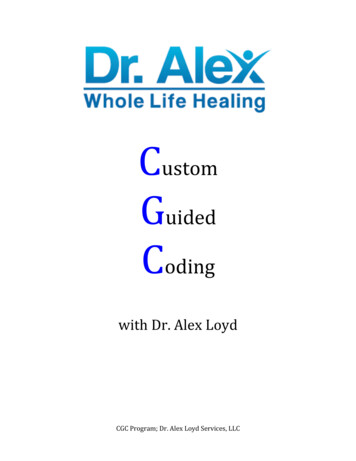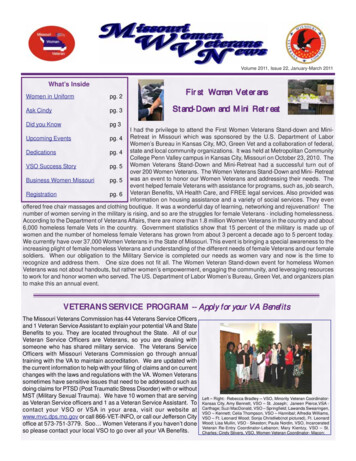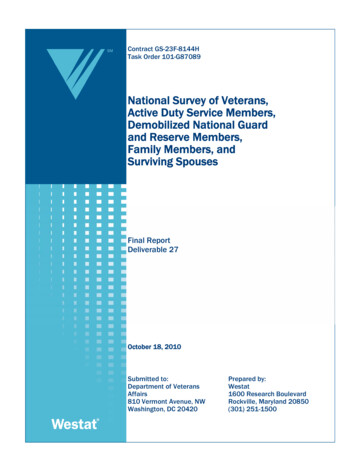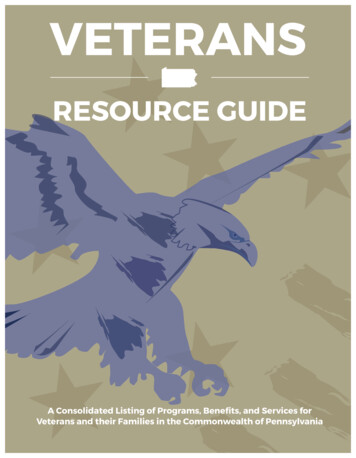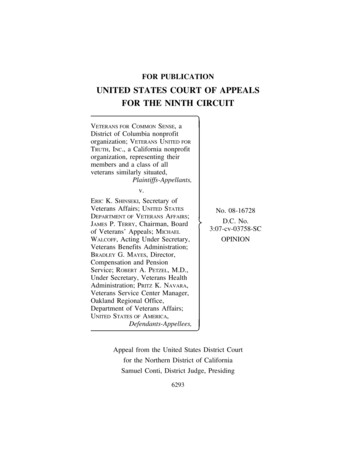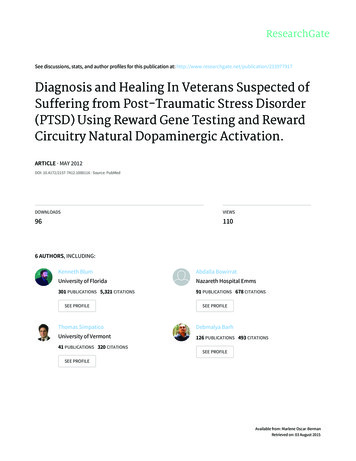
Transcription
See discussions, stats, and author profiles for this publication at: iagnosis and Healing In Veterans Suspected ofSuffering from Post-Traumatic Stress Disorder(PTSD) Using Reward Gene Testing and RewardCircuitry Natural Dopaminergic Activation.ARTICLE · MAY 2012DOI: 10.4172/2157-7412.1000116 · Source: PubMedDOWNLOADSVIEWS961106 AUTHORS, INCLUDING:Kenneth BlumAbdalla BowirratUniversity of FloridaNazareth Hospital Emms301 PUBLICATIONS 5,321 CITATIONS91 PUBLICATIONS 678 CITATIONSSEE PROFILESEE PROFILEThomas SimpaticoDebmalya BarhUniversity of Vermont126 PUBLICATIONS 493 CITATIONS41 PUBLICATIONS 320 CITATIONSSEE PROFILESEE PROFILEAvailable from: Marlene Oscar-BermanRetrieved on: 03 August 2015
Page 1 of 1Manuscript InformationJournal name: Journal of Genetic Syndromes & Gene TherapyNIHMSID: NIHMS431379Manuscript Title: Diagnosis and Healing In Veterans Suspected of Sufferingfrom Post- Traumatic Stress Disorder (PTSD) Using RewardGene Testing and Reward Circuitry Natural DopaminergicActivationPrincipal Investigator: Marlene OSCAR. Berman (oscar@bu.edu)Submitter: Navata E. Edupuganti t/Support InformationNameSupport ID#TitleMarlene OSCAR. Berman R01 AA007112Manuscript 1-2157-7412-3116.pdfSizeUploaded1116257 2012-12-26 06:40:42This PDF receipt will only be used as the basis for generating PubMed Central (PMC)documents. PMC documents will be made available for review after conversion (approx. 2-3weeks time). Any corrections that need to be made will be done at that time. No materials will bereleased to PMC without the approval of an author. Only the PMC documents will appear onPubMed Central -- this PDF Receipt will not appear on PubMed Central.file://F:\AdLib NIHMS43. 12/26/2012
ISSN:2157-7412The International Open AccessJournal of Genetic Syndromes & Gene TherapyExecutive EditorsKenneth BlumUniversity Of Florida, USALee Philip ShulmanNorthwestern University, ChicagoJasti S.RaoUniversity of Illinois College of Medicine, USARoland W. HerzogUniversity of Florida, USAGregory M. PastoresNew York University School of Medicine, New YorkAvailable online at: OMICS Publishing Group (www.omicsonline.org)This article was originally published in a journal by OMICSPublishing Group, and the attached copy is provided by OMICSPublishing Group for the author’s benefit and for the benefit ofthe author’s institution, for commercial/research/educational useincluding without limitation use in instruction at your institution,sending it to specific colleagues that you know, and providing a copyto your institution’s administrator.All other uses, reproduction and distribution, including withoutlimitation commercial reprints, selling or licensing copies or access,or posting on open internet sites, your personal or institution’swebsite or repository, are requested to cite properly.Digital Object Identifier: http://dx.doi.org/10.4172/2157-7412.1000116
Genetic Syndromes & Gene TherapyBlum et al., J Genet Syndr Gene Ther 2012, entaryOpen AccessDiagnosis and Healing In Veterans Suspected of Suffering from PostTraumatic Stress Disorder (PTSD) Using Reward Gene Testing and RewardCircuitry Natural Dopaminergic ActivationKenneth Blum1,2,3,4,5,6,7*, John Giordano2, Marlene Oscar-Berman7, Abdalla Bowirrat8, Thomas Simpatico9 and Debmalya Barh5Department of Psychiatry& McKnight Brain Institute, University of Florida College of Medicine, Gainesville, FL, USADepartment of Holistic Medicine G&G Holistic Addiction Treatment Center, North Miami Beach, FL, USADominion Diagnostics, Inc., North Kingstown, RI, USA4Department of Clinical Neurology, Path Foundation, New York, NY, USA5Institute of Integrative Omics and Applied Biotechnology (IIOAB), Nonakuri, Purba Medinipur, West Bengal, India6Department of Clinical Medicine, Malibu Beach Recovery Center, Malibu Beach, CA, USA7Department of Psychiatry, Boston University School of Medicine, and Boston VA Healthcare System, Boston, MA, USA8Clinical Neuroscience and Population Genetics, The Nazareth English Hospital (EMME), Nazareth, Israel9Department of Psychiatry, University of Vermont, Burlington, VT, USA123AbstractThere is a need for understanding and treating post-traumatic stress disorder (PTSD), in soldiers returning to theUnited States of America after combat. Likewise, it would be beneficial to finding a way to reduce violence committedby soldiers, here and abroad, who are suspected of having post-traumatic stress disorder (PTSD). We hypothesizethat even before combat, soldiers with a childhood background of violence (or with a familial susceptibility risk) wouldbenefit from being genotyped for high-risk alleles. Such a process could help to identify candidates who would beless suited for combat than those without high-risk alleles. Of secondary importance is finding safe methods to treatindividuals already exposed to combat and known to have PTSD. Since hypodopaminergic function in the brain’sreward circuitry due to gene polymorphisms is known to increase substance use disorder in individuals with PTSD,it might be parsimonious to administer dopaminergic agonists to affect gene expression (mRNA) to overcome thisdeficiency.Keywords: Post-Traumatic Stress Disorder (PTSD); RewardDeficiency Syndrome (RDS); Gene testing, Dopamine, KB220Possible Genotyping for Risk of PTSDPost-traumatic stress disorder (PTSD) is a well known prevalentanxiety disorder marked by behavioral, physiologic, and hormonalalterations. PTSD is disabling and commonly follows a chronic course.The etiology of PTSD is unknown, although exposure to a traumaticevent constitutes a necessary, but not sufficient, factor. Although thebiological underpinnings of immediate and protracted trauma-relatedresponses are extremely complex, 40 years of research on humansand other mammals has demonstrated that trauma (particularlytrauma early in the life cycle) has long-term effects on neurochemicalresponses to stressful events. These effects include the magnitudeof the catecholamine response and the duration and extent of thecortisol response. In addition, a number of other biological systemsare involved, including mesolimbic brain structures and variousneurotransmitters. In contrast to other major psychiatric disorders,large studies have not been executed in which underlying genes forPTSD have been identified, but clues are emerging. Complementaryapproaches for locating involved genes include association-basedstudies employing case-control or parental genotypes for transmissiondisequilibrium analysis, and quantitative trait loci studies in nonhumananimal models. Our laboratory and many others are in the process ofidentifying susceptibility genes that will increase our understanding oftraumatic stress disorders and help to elucidate their molecular basis.However, there are serious ethical and political concerns as to whetheror not governments should genotype soldiers for specific geneticpolymorphisms of any trait, including those linked to a high risk ofPTSD exposed to traumatic events like combat.J Genet Syndr Gene TherISSN:2157-7412 JGSGT an open access journalPTSD PrevalenceMilitary conflicts inevitably produced war-related illness amongour troops and veterans. Although the biological underpinnings ofimmediate and protracted trauma-related responses are extremelycomplex, 40 years of research on humans and other mammals havedemonstrated that trauma has long-term effects on neurochemicalresponses to stressful events [1].These effects include the magnitude of the catecholamine responseand the duration and extent of the cortisol response. In addition, anumber of other biological systems are involved, including mesolimbicbrain structures and various other neurotransmitters. Understandingmany of the genetic and environmental interactions contributingto stress-related responses has provided a map for the diagnosis andtreatment of individuals vulnerable to PTSD (Table 1).High rates of PTSD in veterans have been found throughouthistory. People have recognized that exposure to combat situationscan negatively impact the mental health of those involved. Further it*Corresponding author: Kenneth Blum, Department of Psychiatry, University ofFlorida Box 100183 Gainesville, FL, 32610-0183; Tel: 352-392-6680; Fax: 352392-8217; E-mail: drd2gene@ufl.eduReceived May 05, 2012; Accepted May 29, 2012; Published May 31, 2012Citation: Blum K, Giordano J, Oscar-Berman M, Bowirrat A, Simpatico T, et al.(2012) Diagnosis and Healing In Veterans Suspected of Suffering from PostTraumatic Stress Disorder (PTSD) Using Reward Gene Testing and RewardCircuitry Natural Dopaminergic Activation. J Genet Syndr Gene Ther 3:116.doi:10.4172/2157-7412.1000116Copyright: 2012 Blum K, et al. This is an open-access article distributed underthe terms of the Creative Commons Attribution License, which permits unrestricteduse, distribution, and reproduction in any medium, provided the original author andsource are credited.Volume 3 Issue 3 1000116
Citation: Blum K, Giordano J, Oscar-Berman M, Bowirrat A, Simpatico T, et al. (2012) Diagnosis and Healing In Veterans Suspected of Suffering fromPost-Traumatic Stress Disorder (PTSD) Using Reward Gene Testing and Reward Circuitry Natural Dopaminergic Activation. J Genet SyndrGene Ther 3:116. doi:10.4172/2157-7412.1000116Page 2 of 4 SLC6A4 (serotonin transporter genedeficiency) Opioid-R mu-1 (OPRM-1) GABRB3 Major (G1) Low FKBP5 mRNA High GILZ mRNA DRD2 A1 DAT1 DBH NF-kB GlucocorticoidApoE- ε2Brain-derived Neurotrophic FactorMonoamine BCNR1Myo6CRF-1 receptorsCRF-2 receptorsNeuropeptide YTable 1: Genes and PTSD.is well understood that there are high rates of Substance Use Disorderin veterans. The diagnosis historically referred to as “combat fatigue,”“shell shock,” or “war neurosis” originates from observations of theeffect of combat on soldiers and the grouping of symptoms that arenow used to characterize PTSD. Interestingly, with regard to Vietnamveterans, approximately 15% of men and 9% of women were found tohave PTSD prior to combat with approximately 30% of men and 27%of women having PTSD at some point in their life following Vietnam.In the Persian Gulf war, PTSD prevalence was 9% to approximately24% [2]. According to the Department of Veterans Affairs (VA) in June2010, there were 171,423 deployed Iraq and Afghanistan war veteransdiagnosed with PTSD, out of a total of 593,634 patients treated in VAfacilities (www.va.gov).Neurogenetic Abnormalities in PTSDOne study of Army soldiers screened up to four months afterreturning from deployment to Iraq showed that 27% met criteria foralcohol abuse and were at increased risk for related harmful behaviors(e.g., drinking and driving, using illicit drugs) [3]. In another studybased on DRD2 allelic association, 35 PTSD patients with the A1( )(A1A1, A1A2) allele consumed more than twice the daily amountof alcohol than the 56 patients with the A1(-) (A2A2) allele, and thisdifference was highly significant [4]. When the hourly rate of alcoholconsumed was compared, A1( ) allelic patients consumed twice therate of the A1(-) allelic patients [4].Serotonin is an important neurotransmitter involved in brainreward circuitry, and serotonergic system dysfunction has beenimplicated in PTSD. Genetic polymorphisms associated with serotoninsignaling may predict differences in brain circuitry involved inemotion processing and deficits associated with PTSD. In healthyindividuals, common functional polymorphisms in the serotonintransporter gene (SLC6A4) have been shown to modulate amygdalaand prefrontal cortex activity in response to salient emotional stimuli.Similar patterns of differential neural responses to emotional stimulihave been demonstrated in PTSD, but genetic factors influencing theseactivations have yet to be examined. Morey et al. [5] found that theSLC6A4 SNPs rs16965628 and 5-HTTLPR are associated with a biasin neural responses to traumatic reminders and cognitive control ofemotions in patients with PTSD.The opioid receptor mu-1 (OPRM1) gene may play a role in bothPTSD and alcohol use. Nugent et al. [6] examined the associationbetween PTSD and drinking motives as well as variation in the OPRM1as a predictor of both PTSD and drinking motives in a sample of 201persons living with HIV (PLH) reporting recent binge drinking. Selfreported PTSD symptom severity was significantly associated withdrinking motives for coping, enhancement, and socialization. OPRM1variation was associated with decreased PTSD symptom severity aswell as enhancement motives for drinking.J Genet Syndr Gene TherISSN:2157-7412 JGSGT an open access journalGABAergic systems have been implicated in the pathogenesis ofanxiety, depression, and insomnia. These symptoms are part of thecore and comorbid psychiatric disturbances in PTSD. Feusner et al.[7] concluded in a population of PTSD patients, heterozygosity of theGABRB3 major (G1) allele confers higher levels of somatic symptoms,anxiety/insomnia, social dysfunction and depression than found inhomozygosity.Variations in genes related to the dopaminergic pathway havebeen implicated in neuropsychiatric disorders such as schizophrenia,substance misuse, Alzheimer’s disease and PTSD. In one particularstudy, Voisey et al. [8] reported that the 957C T polymorphism in theD2 dopamine receptor (DRD2) gene is one of the genetic factors forsusceptibility to PTSD. Lawford et al. [9] identified clusters of patientswith PTSD according to symptom profile and examined the associationof the A1 allele of the DRD2 gene with these clusters. They found thatveterans with the DRD2 A1 allele — compared to those without thisallele — were significantly more likely to be found in the high thanthe low psychopathology cluster group. In agreement with thosefindings, Comings et al. [10] suggested that a DRD2 variant in linkagedisequilibrium with the D2A1 allele confers an increased risk to PTSD,and the absence of the variant confers a relative resistance to PTSD.Moreover, Valente et al. [11] found a statistical association betweenDAT1 3’UTR VNTR nine repeats and PTSD (OR 1.82; 95% CI, 1.202.76). This preliminary result confirmed previous reports supporting asusceptibility role for allele 9 and PTSD.van Zuiden et al. [12] investigated whether glucocorticoidreceptor (GR) pathway components assessed in leukocytes beforemilitary deployment represent preexisting vulnerability factors fordevelopment of PTSD symptoms. In predeployment high GR number,low FKBP5 mRNA expression, and high GILZ mRNA expressionwere independently associated with increased risk for a high level ofPTSD symptoms. Childhood trauma also independently predicteddevelopment of a high level of PTSD symptoms. Additionally, theinvestigators observed a significant interaction effect of GR haplotypeBclI and childhood trauma on GR number.Nuclear factor-κB (NF -κB) is a ubiquitously expressed transcriptionfactor for genes involved in cell survival, differentiation, inflammation,and growth. Cohen et al. examined the role of NF-κB pathway in stressinduced PTSD-like behavioral response patterns in rats. Extremebehavioral responder animals displayed significant upregulationof p50 and p65 with concomitant downregulation of I-κBα, p38,and phospho -p38 levels in hippocampal structures,compared withminimal behavioral responders and controls. Immediate post-exposuretreatment with high-dose corticosterone and a selective NF-κB inhibitor(pyrrolidine dithiocarbamate ) significantly reduced prevalence rates ofextreme responders and normalized the expression of those genes. Theauthors suggested that stress-induced upregulation of NF-κB complexin the hippocampus may contribute to the imbalance between what arenormally precisely orchestrated and highly coordinated physiologicaland behavioral processes, thus associating it with stress-relateddisorders.Testing Genetic AntecedentsOur laboratory, proposed in a recent article [13] that successfultreatment of PTSD will involve preliminary genetic testing for specificpolymorphisms. Due to the complex etiology of PTSD, for whichexperiencing a traumatic event results in a specific phenotype, it maybe difficult to identify even via genetic analysis. The consensus ofVolume 3 Issue 3 1000116
Citation: Blum K, Giordano J, Oscar-Berman M, Bowirrat A, Simpatico T, et al. (2012) Diagnosis and Healing In Veterans Suspected of Suffering fromPost-Traumatic Stress Disorder (PTSD) Using Reward Gene Testing and Reward Circuitry Natural Dopaminergic Activation. J Genet SyndrGene Ther 3:116. doi:10.4172/2157-7412.1000116!the literature suggests that interactions between different genes (e.g.DRD2 and DAT1 genes) and between them and the environment makecertain people vulnerable to developing PTSD [14]. Certainly geneenvironmental studies are needed that focus more narrowly on specific,distinct endophenotypes and on influences from environmental factors.However testing for polymorphisms of genes that have already beenfound to associate with PTSD will provide a powerful tool to diagnosesuspected veterans after deployment. Results of our research suggest thefollowing genes should be tested: serotoninergic, dopaminergic (DRD2,DAT, DBH), glucocorticoid, GABAergic (GABRB), apolipoproteinsystems (APOE2), brain-derived neurotrophic factor, Monamine B,CNR1, Myo6, CRF-1 and CRF-2 receptors, and neuropeptide Y (NPY)[15].Natural Dopaminergic ActivationPage 3 of 4PTSD diagnosis and treatment!! NWWW' WGWW' WWWW' WWWW'V WW'VNWW'XYWW'VNWW'VWWW' WWW'XGWW'XYWW'XGWW'!X&WW'XWWW'% 'PTSD diagnosis and dy involving oral KB220Z. Results showed an increase of alpha&YWW'waves and low beta wave activity in the parietal brain region (Figure 2). Significant differencesNWWW'observed between placebo and KB220Zª consistently occurred in the frontal regions after WeekW'1, and then again after Week 2 of analyses. This is the first report to demonstrate involvement ofG'X'Y' ' B' X'theprefrontalcortexconductancein the qEEG responseto aPlacebonatural putativeagonistFigure1: Skinlevels for(AP, nD2 12)and(KB220Zª),Experimental(AI, n 15)groups.(ModifiedfromBlumet al.,2009,permission.).especiallyin individualswiththe dopamineD2 A1allele.Figure1.evidentSkinconductancelevelsfor Placebo(AP,nwith 12)and Experimental (AI, n 15)EEO'%\),Q -*' ,D* '(?/5 ,T,Q-)' ]) 7'Early detection is especially important, because early treatment canimprove outcome and potentially reduce vulnerability to PTSD priorgroups. (Modified from Blum et al., 2009, with permission.)to exposure to trauma, as well as help to heal those who have developedGY[X'Figure 1 shows the skin conductance values for the KB220 polydrug (AI) and placebo (AP)PTSD symptomatology. When genetic testing reveals deficiencies, W'vulnerable individuals can be recommended for treatment with “bodygroups. On Day 7, the difference between the groups was significant (p 0.025; within groups, pGW'friendly” [16] pharmacologic substances and/or nutrients. One goal of 0.025). After the effect of the first seven days, the striking finding was that the curves for theour research has been to develop a treatment that would up-regulateBG[X'&W'the expression of reward genes in order to bring about a feeling of welltwo groups mirrored one another, although the KB220 groups are lower. This may indicate abeing (e.g., by enhancing dopaminergic function) as well as a reduction Q05*\,'commonality inBW'response to the dynamics of the treatment program,or it may indicateNN[BX'in the frequency and intensity of the symptoms of PTSD. Specifically,FANWWL'we developed KB220Z a natural dopaminergic activator having notcharacteristic changesin the population with recovery groups. In contrast, distinctive changesNW' B[VG'only important anti-stress properties but anti-craving actions as well.occurred within groups. By Day 9, the polydrug-KB220 group showed a marked time-dependentOur published research [17] has consistently shown anti-anxiety effects W'of KB220 variant in double-blinded placebo controlled studies in highlysignificant improvement. At Day 13, a second significant change occurred with respect to daysW'addicted subjects (Figure 1).11, 17, and 21. In contrast%Q1J0'V9 N'IL'to the AP group, the AI A*-0 ' N9 G'IZ'group showed a significant change, whichFigure 1 shows the skin conductance values for the KB220 polydrug RR@'A0.3)'occurred later at Day 13, and continued through Day 21.(AI) and placebo (AP) groups. On Day 7, the difference between theFigure 2: qEEG Study: KB220Z compared to placebo in psychostimulant(Blumet al. IIOAB1(1) 2011;derivedfrom Blumet al.,groups was significant (p 0.025; within groups, p 0.025). After theIn addicts.an attemptto overcomeqEEGLettersabnormalitiesin cohortof abstinentpsychostimulantFigure2. qEEG Study:KB220Zcompared to placebo in psychostimulant addicts. (Blum et al.PostgraduateMedicine,2010.).effect of the first seven days, the striking finding was that the curves forabusers, our laboratory studied the effects of KB220Z (see Chen et al. 2011, for a review onIIOAB Letters 1(1) 2011; derived from Blum et al., Postgraduate Medicine, 2010.)the two groups mirrored one another, although the KB220 groups arelower. This may indicate a commonality in response to the dynamicsKB220Z).Positive outcomeswere demonstratedqEEGimaging inthea randomized,triple-blind,diagnosticand treatmentmap, whichbywillilluminatevulnerabilityof the treatment program, or it may indicate characteristic changes ccessful!the population with recovery groups. In contrast, distinctive changestreatment of PTSD will involve preliminary genetic testing for*!occurred within groups. By Day 9, the polydrug-KB220 group showedspecific polymorphisms. Early detection is especially important,!a marked time-dependent significant improvement. At Day 13, abecause early treatment can improve outcome. When genetic testingsecond significant change occurred with respect to days 11, 17, and 21.revealsdeficiencies, vulnerable individuals can be recommended for " !!In contrast to the AP group, the AI group showed a significant change,treatment with “body friendly” pharmacologic substances and/orwhich occurred later at Day 13, and continued through Day 21.nutrients. Consensus suggest the following genes should be tested:serotoninergic, dopaminergic (DRD2, DAT, DBH), glucocorticoid,In an attempt to overcome qEEG abnormalities in cohort ofGABAergic (GABRB), apolipoprotein systems (APOE2), brainabstinent psycho stimulant abusers, our laboratory studied the effectsderived neurotrophic factor, Monamine B, CNR1, Myo6, CRF-1 andof KB220Z [18]. Positive outcomes were demonstrated by qEEGCRF-2 receptors, and neuropeptide Y (NPY). Treatment in part shouldimaging in a randomized, triple-blind, placebo-controlled, crossoverbe developed that would up-regulate the expression of these genesstudy involving oral KB220Z. Results showed an increase of alphato bring about a feeling of well being, as well as a reduction in thewaves and low beta wave activity in the parietal brain region (Figurefrequency and intensity of the symptoms of PTSD.2). Significant differences observed between placebo and KB220Z consistently occurred in the frontal regions after Week 1, and thenConclusionsagain after Week 2 of analyses. This is the first report to demonstrateSoldiers involved in combat consistently show high rates ofinvolvement of the prefrontal cortex in the qEEG response to a naturalPTSD. There has been some difficulty in accurately diagnosingputative D2 agonist (KB220Z ), especially evident in individuals withthe true endophenotype of PTSD in returning veterans [19]. Wethe dopamine D2 A1 allele.propose that by incorporating genetic testing of a number of rewardOur Proposalgene polymorphisms already known to associate with PTSD [13],diagnosis will become more evident and accurate. Additionally, weAn understanding of the many genetic and environmentalpropose that the existing qEEG abnormalities observed in PTSD,interactions contributing to stress-related responses will provide aJ Genet Syndr Gene TherISSN:2157-7412 JGSGT an open access journalVolume 3 Issue 3 1000116
Citation: Blum K, Giordano J, Oscar-Berman M, Bowirrat A, Simpatico T, et al. (2012) Diagnosis and Healing In Veterans Suspected of Suffering fromPost-Traumatic Stress Disorder (PTSD) Using Reward Gene Testing and Reward Circuitry Natural Dopaminergic Activation. J Genet SyndrGene Ther 3:116. doi:10.4172/2157-7412.1000116Page 4 of 4which are further enhanced with increasing substance use disordersin individuals with PTSD, can be attenuated by the administration ofthe natural dopaminergic activator KB220Z, a promising geneticallydesigned therapeutic safe substance. Our proposal is based on over 27clinical trials with KB220 variants (a key ingredient in SynaptaGenX distributed by Nupatways, Indianapolis, Indiana). KB220 variants havedocumented effects in overcoming qEEG abnormalities in protractedabstinent psychostimulant abusers, and documented anti anxietyeffects as well. Thus, after confirmatory large clinical trials includingneuroimaging, KB220Z may be confirmed as a helpful adjunctiveintervention for PTSD, because it not only activates dopaminergicpathways, but it also potentially could enhance dopamine D2 receptordensity, thereby attenuating the negative behavioral effects of subjectsdiagnosed with PTSD.Conflict of InterestKenneth Blum is an officer and stock holder of LifeGen, Inc., Lederach, PA,USA. LifeGen Inc. is the worldwide exclusive distributor of products related topatents concerning Reward Deficiency Syndrome. John Giordano is a LifeGenpartners.AcknowledgementsSupport for the writing of this paper came from the US Department ofVeterans Affairs Medical Research Service and NIAAA grants R01-AA07112 andK05-AA00219 to MO-B. Additional funding came from grants awarded to PATHResearch Foundation from LifeExtension Foundation, LifeGen Inc., Lederach,PA, USA.and Dominion Diagnostics, Inc. Thomas Simpatico is the recipient ofSAMHSA Award #SM058809: Veteran’s Jail Diversion & Trauma Recovery Grant.References1. Miller G (2011) The invisible wounds of war. Healing the brain, healing themind. Science 333: 514-517.2. Tull M (2009) About.com Guide. July 22, 20093. Beevers CG, Lee HJ, Wells TT, Ellis AJ, Telch MJ ( 2011) Association ofpredeployment gaze bias for emotion stimuli with later symptoms of PTSD anddepression in soldiers deployed in Iraq. Am J Psychiatry 168: 735-741.4. Young RM, Lawford BR, Noble EP, Kann B, Wilkie A, et al. (2002) Harmfuldrinking in military veterans with post-traumatic stress disorder: associationwith the D2 dopamine receptor A1 allele. Alcohol Alcohol. 37: 451-456.5. Morey RA, Hariri AR, Gold AL, Hauser MA, Munger HJ, et al. (2011) Serotonintransporter gene polymorphisms and brain function during emotional distractionfrom cognitive processing in post-traumatic stress disorder. BMC Psychiatry11: 76.12. van Zuiden M, Geuze E, Willemen HL, Vermetten E, Maas M, et al. (2011)Glucocorticoid receptor pathway components predict post-traumatic stressdisorder symptom development: a prospective study. Biol Psychiatry 71: 309316.13. Bowirrat A, Chen TJ, Blum K, Madigan M, Bailey JA, et al. (2010) Neuropsychopharmacogenetics and Neurological Antecedents of Post-traumaticStress Disorder: Unlocking the Mysteries of Resilience and Vulnerability. CurrNeuropharmacol 8:335-358.14. Bailey JN, Goenjian AK, Noble EP, Walling DP, Ritchie T, et al. (2010)PTSDand dopaminergic genes, DRD2 and DAT, in multigenerational familiesexposed to the Spitak earthquake. Psychiatry Res 178: 507-510.15. Blum K, Fornari F, Downs, BW, Wait, RL, Giordano J, et al. (2011) GeneticAddiction Risk Score (GARS): Testing for polymorphic predisposition andrisk to Reward Deficiency Syndrome(RDS). Chapter19 in “Gene TherapyApplications”. (Ed: King C) InTech, Rijeka, Croatia.16. Downs BW, Chen AL, Chen TJ, Waite RL, Braverman ER, et al. (2009)Nutrigenomic targeting of carbohydrate craving behavior: can we manageobesity and aberrant craving behaviors with neurochemical pathwaymanipulation by Immunological Compatible Substances (nutrients) using aGenetic Positioning System (GPS) Map? Med Hypotheses 73: 427-434.17. Blum K, Chen A, Chen TJH, Bowirrat A, Waite RL (2009) Putative Targetingof dopamine D2 receptor function in reward deficiency syndrome (RDS) bySynapatmine Complex Variant (KB220): Clinical trial showing anti-anxietyeffects. Gene Ther Mol Biol 13: 214-230.18. Chen TJ, Blum K, Chen AL, Bowirrat A, Downs WB, et al. (2011) Neurogeneticsand clinical evidence for the putative activation of the brain reward circuitryby a neuroadaptagen: proposing an addiction candidate gene panel map. JPsychoactive Drugs 43: 108-127.19. Cornelis MC, Nugent NR, Amstadter AB, Koenen KC (2010) Genetics of posttraumatic stress disorder: review and recommendations for genome-wideassociation studies. Curr Psychiatry Rep 12: 313-326.20. Amin MM, Parisi JA, Gold MS, Gold AR (2010) War-related illness symptomsamong Operation Iraqi Freedom/Operation Enduring Freedom returnees. MilMed 175: 155-157.21. Braverman ER, Blum K (1996) Substance use disorder exacerbates brainelectrophysiological abnormalities in a psychiatrically-ill population. ClinElectroencephalogr 27: 5-27.22. Jokić -Begić N, Begić D (2003) Quantitative electroencephalogram (qEEG) incombat veterans with post-traumatic stress disorder (PTSD). Nord J Psychiatry57: 351-355.6. Nugent NR, Lally MA, Brown L, Knopik VS, McGeary JE (2011) OPRM1 andDiagnosis-Related Post-traumatic Stress Disorder in Binge-Drinking PatientsLiving with HIV. AIDS Behav.7. Feusner J, Ritchie T, Lawford B, Young RM, Kann B, et al. (2001) GABA(A)receptor beta 3 subunit gene and psychiatric morbidity in
This PDF receipt will only be used as the basis for generating PubMed Central (PMC) documents. PMC documents will be made available for review after conversion (approx. 2-3 weeks time). Any corrections that need to be made will be done at that time. No materials will be released to PMC without the approval of an author.

